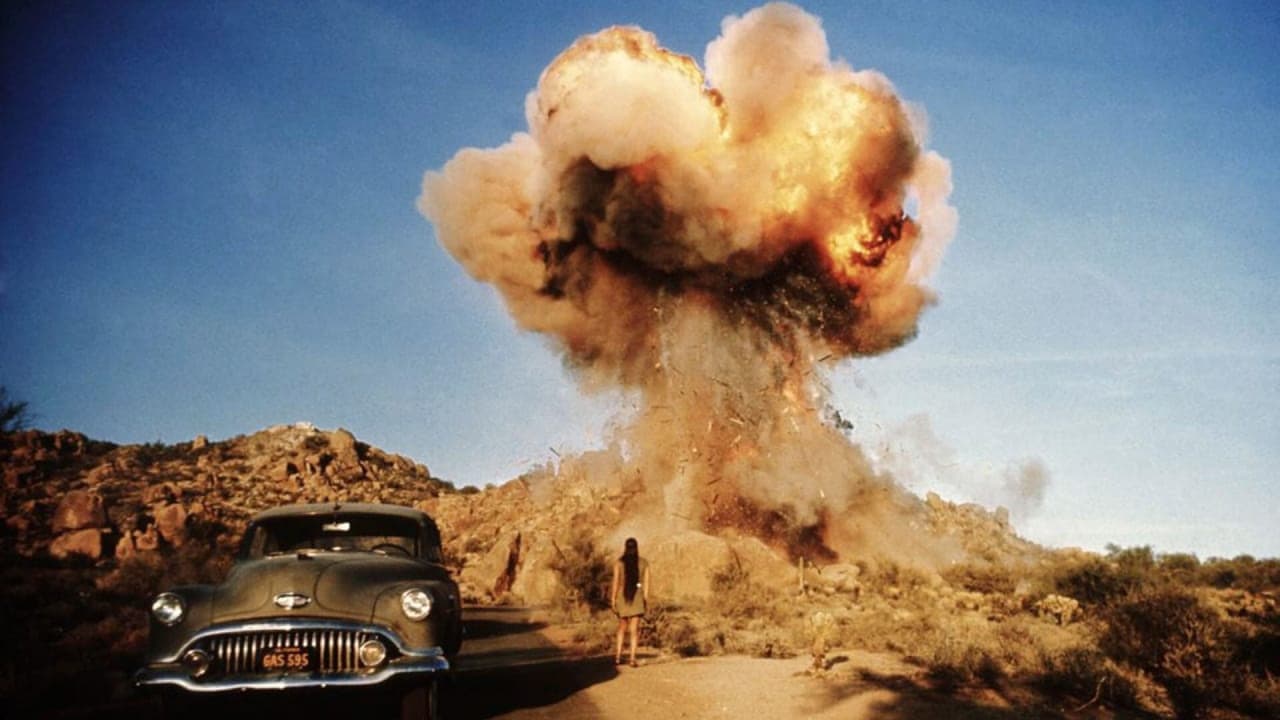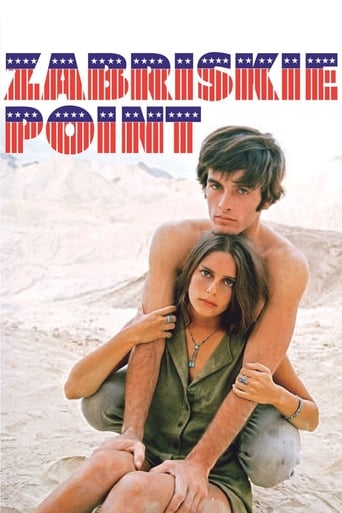

Being a teenager back when this film came out, I guess I would have a different opinion if I had watched back then. Unfortunately, it stayed on my 'I've got to see this movie some day' list until I was long past part of the intended audience.Today it feels like it's a joke about American society. The student revolutionaries could spend all their time arguing about whether their school is bad or if it is bad and mean. The scary thing is a lot of those students now can only find jobs in those schools or some other government entity where productivity is unimportant.But as much as I have enjoyed watching Blow-Up over the years, it at least had a point to the story. I've had a lot of balloons that have had better points. Antonioni must think he was the first to discover there is a generation gap and the young are just free and easy with life and love. The photography and the music are the best things about ZP - it sure isn't the acting. Antonioni intentionally hired amateurs for the leads and it shows. Even the stereotypes he hired had trouble playing the stereotypes they actually were. Evidently from their minuscule list of credits no one else saw any acting ability in them either.I could have used more Pink Floyd and Grateful Dead and all other music. There could have been an extended version of Dark Star over all the shots of Daria driving in the desert and it would have made the tedious parts bearable.If you have a couple hours with nothing absolutely nothing to do take the time to watch what Antonioni saw happening in America at the end of the '60s. But know you have been warned.
... View Moreit seems very strange to define it. because it has the sin and the virtue to be not exactly a film. maybe an experiment. but not in real sense. a collection of images and emotions, a parable or a game, opportunity for two young people to perform, a critic to social absurdity, a confession or a build of new world. colors and image and simple poetry of image and sketch of story. this is all. nothing for impress . but to translate a state of soul, the tension of a period, the desire/need to return to the original peace. the film is not a manifesto or a demonstration of the art of Antonioni. it is only skin for a state of soul. and this does it special. strange. and memorable.
... View MoreI'd heard a lot about this movie and finally got a chance to watch it tonight. It was, well, different.The screenplay by five writers (that's a bad sign right there) picks up themes and drops them to go on to something else. It's as the creative team collectively had AD/HD. Oh, there's something shiny. Let's walk over and pick it up.The action starts in Los Angeles with a well realized meeting of a campus revolutionary group. Because of the film's being forty-six years old, these scenes carry their own irony: I wondered how many of those committed rebels from 1970 would turn out to be Realtors and salespeople and advertising executives ten years later.A self-absorbed man named Mark is marginally involved with the group. He's a dropout who had rewired the university's computer system to enroll all Engineering majors in Art classes. He's on the scene of a riot where a policeman is shot and he flees, eventually stealing an airplane and heading for the desert.In the second act he meets up with Daria, a secretary who's an Anthropology major. They meet cute: he terrorizes her on the highway as she'd driving through the California desert. She's gone there to look for a friend who's working with emotionally disturbed children (at one point I thought I was watching CHILDREN OF THE CORN) but like too many other dramatic themes that got lost too.In the desert they drop acid, which prompts an endless scene of people covered in sand having sex. This grinds the narrative to a halt, therefore giving audiences an opportunity to get popcorn and a drink without missing anything, they same way that Mexican horror movies often have gratuitous musical numbers in the second act.Mark takes the stolen plane back to Los Angeles, with predictable results.In the mercifully short third act Daria goes to her boss's house, then leaves and imagines first the house blowing up and then repeated shots of clothing, appliances, and a loaf of Wonder bread blowing up. I'm sure that those few audiences who saw the film in theaters were convulsed with laughter during this scene. Fortunately, her imagination is limited so she drives away at sunset.Neither of the leads had acting experience, and it shows. There is no consistency to their performances. And, giving how poorly written the film is, I can't blame them. Neither had further careers in film, which surprised no one. Other characters are very uneven. Some perform naturally, others sound as if they had just that moment been handed the script and asked to read it aloud.The director's native language is Italian. At the end of the scene if the actors didn't run into each other, fall down, or belch while facing the camera, it seems he would announce that this was a final take, "Cut and print!" What's puzzling is that the film cost $7 million in 1970 dollars, about $44 million in 2016 dollars. But it looks and sounds cheap. If you didn't see the opening titles to know it was from MGM and directed by Antonioni, a viewer would figure it was one of those low budget action/adventure movies that Roger Corman cranked out at New World Pictures.There are the special effects at the end, of course. And performance rights to songs by the Rolling Stones, Grateful Dead, Roy Orbison, and many other rock legends. But this wasn't adapted from a best seller, and there are no box office names except for Rod Taylor, who plays Daria's boss.In defense of the film, though, it was cut and recut over and over by MGM and came very close to never being released. I suspect that somewhere in a vault at the studio is enough unused footage to assemble twenty different cuts of the film that are completely different from each other.Antonioni's film that's known by the public is his masterpiece BLOW-UP, which had no explosions. Here he brings us Zabriskie Point, which has explosions but no point.
... View MoreFor understanding Antionioni's Zabriskie Point', you need insight in the ways of the alternative-thinking American youngsters from the late 19-Sixties. In connection with student-riots at Berkely, their protests were aimed against the behavior of their parent's generation.Only on this condition you'll be able to appreciate 'Zabriskie Point' to the full. Admiring the excellent capturing of its spirit, supported by its magnificent picturing -- another famous Antonioni- trademark. From these points of view, 'Zabriskie Point' nowadays almost shows as a historical documentary.For those who were not around at the time, I guess 'Zabriskie Point' turns out somewhat disappointing. This film surely bears all Antonioni high-quality marks, yes, but its plot makes little sense. Might even be considered as dull. Its only moments of good tense are provided in the scene where the boy meets the girl. Involving his low-flying airplane over the car driven by her.
... View More